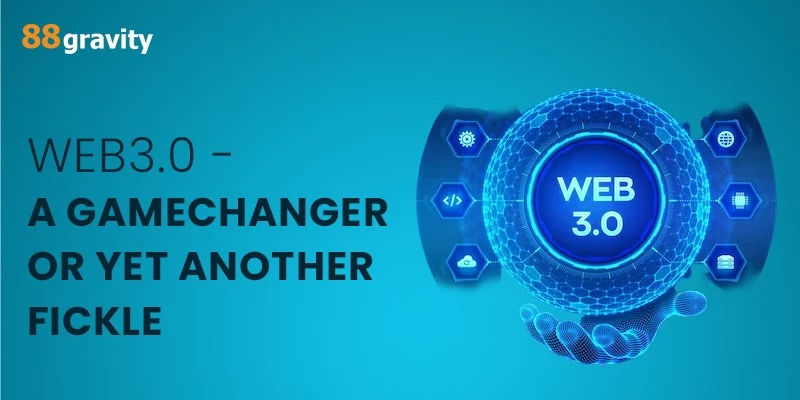
Do you find technology and digital developments interesting? You undoubtedly then heard the term "WEB 3.0." Of course, you want to know what it is and why there is so much hoopla about it. However, it isn't really that well defined yet. But, it is perfectly understandable that the future will not be exactly as it appears or as we anticipate. Although the definition of this term is still being developed, it will undoubtedly impact us quickly. Therefore it is preferable to be prepared so that we can begin utilizing it to its full potential.
We do know that Web 3.0 refers to a concept that characterizes a new era. Let's take a deep dive into the history of Web 3.0 to better comprehend the changes it brings to digital marketing services.
Where does Web 3.0 originate?
Most of us can recall what Web 1.0 looked like—those static websites with frames, tables, and gif buttons connected to our first online encounter. Do you recall the static, non-interactive read-only pages when we acted as information consumers and recipients?
Web 2.0 was created in 2004 and is essentially defined by the information and back-and-forth communication between users and websites. The introduction of the new technology JavaScript, which makes website interaction easier, also happens to be a significant milestone in internet history. With the help of this technology, our use of the internet has completely changed. Rather than being only information consumers, we can now actively contribute to its creation however, as we have been able to see more clearly over the past few years. Web 2.0 also introduced some delicate privacy concerns.
If you don't recall this historical period, consider the first time you used Wikipedia, which consists of static pages with only text, links, and photos with any additional features like profiles, on-page actions or events, separate galleries, etc. This time is also known as a reader-only, in which the users were seen as the ones who consumed the content provided on the page. We cannot make money by clicking on the ads displayed on a particular internet page, which were nonexistent.
How well do you grasp Web 3.0?
The internet is a constantly evolving idea that is recognized as a major turning point in human interaction, communication, and business. Web 1.0 ushers in static web pages, while Web 2.0 increases user interaction by generating the content. And now we have Web 3.0, which introduced social media portals and user-generated content. Continue reading and learn about Web 3.0's potential and the various difficulties it is facing to learn how this revolution is genuinely changing the game.
Web 3.0 is an ideal version of the Internet in which information and applications are saved and controlled on decentralized networks. It is often referred to as the decentralized web or the semantic web. Web 3.0, in contrast to its forerunners, promises to provide consumers greater authority over their data and browsing experiences by reducing reliance on centralized entities. Blockchain and other distributed computing technologies are the foundation of Web 3.0, enabling interactions between individuals and developing trustless systems.
The Decentralization and Trust of Web 3.0: The potential for Web 3.0 to do away with the need for middlemen is one of its key promises. Direct user-to-user transactions and interactions are made possible by blockchain technology and smart contracts, promoting transparency and building user trust.
Ownership of Data and Privacy: Web 3.0 gives users the option to own their data, according to a digital marketing company in Gurgaon. In contrast to Web 2.0, where data is frequently collected and monetized by big tech companies with no explicit authorization, this represents a substantial shift.
Enhanced the power of Security: Web 3.0's decentralized architecture may make it more resistant to data breaches and online threats. Cryptographic techniques and distributed data storage can improve security and safeguard user data.
Tokenization with Digital Advantages: Web 3.0 makes it possible to create and trade tokens and digital assets. New business models that encourage user engagement and content development may result from this.
Interoperability: Web 3.0 is being used by the high-tech digital marketing company in Gurgaon to build a more interconnected and interoperable internet. Across many platforms and ecosystems, data and apps can be easily exchanged and accessed.
The Problems with Web3.0
Ascendable Blockchain networks, a key element of Web 3.0, continue to struggle with scalability issues. Many decentralized systems have lower throughput as compared to conventional centralized alternatives, which prevents widespread adoption.
Experience of Users: For non-technical users, the present user experience on decentralized applications (dApps) can be cumbersome and perplexing. User-friendly interfaces must be prioritized for Web 3.0 to flourish.
Regulation and Governance: Web 3.0's decentralized structure creates difficulties for regulation and governance. It might be difficult to deal with problems like illegal content or fraudulent activity when there is no centralized authority.
Impact of Environmental: There are worries about the environmental impact of several well-known blockchain networks because they rely on energy-intensive resolution techniques. The long-term viability of Web 3.0 will depend on how it handles sustainability.
Conclusion
With its focus on providing a more user-centric, decentralized, and secure digital environment, Web 3.0 has the potential to alter the way the Internet operates significantly. Hiring expert SEO services in Gurgaon, which use the most recent technology and market trends to make your business shine like no other, is necessary if you want to make benefits from this technology. The allure of Web 3.0 lies in its claims of data ownership, improved security, and creative business models. But it also has issues with regulation, user experience, scalability, and environmental sustainability.
How these problems are solved will determine if Web 3.0 is a real game-changer or just a fad. Web 3.0 might progressively permeate other facets of our online life as technological advances and inventions continue, altering the internet for future generations. We must carefully navigate this rapidly changing digital ecosystem as users, creators, and policymakers to unlock its potential for the common good.
